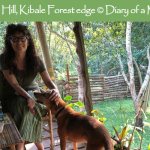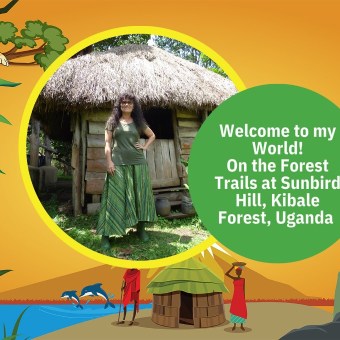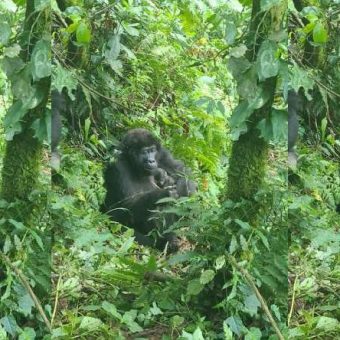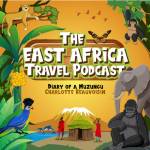
BBC’s “Spy in the Wild” series meets Uganda’s Mountain Gorillas. Diary of a Muzungu interviews Uganda’s premier vet Dr Gladys about the making of the documentary.
I recently received a wonderful press article from my correspondent in the UK – a.k.a. my dad! – who is always on the look-out for stories about Uganda and East Africa in the British press.
The Times article “Spy ape isn’t rumbled in the jungle” is all about an animatronic gorilla who has been hanging out in Bwindi Impenetrable Forest with Uganda’s mountain gorillas.
I’m lucky enough to have encountered a few mountain gorillas in the wild – but this footage is in a league of its own. Watch it now!
I wanted to know more about this thrilling project here in Uganda and contacted Dr Gladys Kalema-Zikusoka, founder and Chief Executive Officer of Conservation Through Public Health (CTPH). Dr Gladys has become “one of the world’s leading conservationists and scientists working to save the critically endangered mountain gorillas of East Africa.”
The Muzungu: Which mountain gorilla family did the animatronic gorilla meet?
Dr Gladys: The Rushegura gorilla group is the family that is shown looking into the spy camera. However, they filmed other gorilla groups as well.
The Muzungu: In what way were you personally involved?
Dr Gladys: I was the lead scientist they consulted when filming “Spy Gorilla.” I accompanied the crew filming the mountain gorillas together with our team from Conservation Through Public Health, after obtaining permission from the Uganda Wildlife Authority, who also joined in the filming.
The Muzungu: How did you hear about this project?
Dr Gladys: Matt Gordon from John Downer Productions contacted me after getting a referral from a fellow National Geographic Explorer called Dr. Jill Pruetz. She was the lead scientist JDP consulted as she had hosted them when they filmed “Spy Chimpanzee” in the first series of “Spy in the Wild” at her study site in Senegal where Savannah Chimpanzees are found.
The Muzungu: What do you hope to learn from this project?
Dr Gladys: I hoped to add to my knowledge about gorilla behaviour because the spy cameras are able to non-intrusively capture close-up images of gorillas without having to get close to them. The spy cameras can record never before seen behaviour that will help us to protect mountain gorillas better and ultimately inspire viewers to conserve them.
The Muzungu: How many hours of filming took place for the film crew to get the one-hour show about Bwindi’s gorillas?
Dr Gladys: It took them ten days to film the documentary.

The Muzungu: Are there any plans for this kind of project to be repeated in Bwindi?
Dr Gladys: Most likely not, because the film crew got a lot of information and it took a lot of time, money and resources to capture this rare footage
The Muzungu: What is your feeling about the gorillas’ reaction to the animatronic gorilla?
Dr Gladys: We were first a bit apprehensive about how the gorillas would react. I also made sure that the spy gorilla was disinfected adequately to prevent any potential disease transmission. With the UWA and CTPH team, we were pleased to see that the gorillas were curious about the animatronic gorilla that looked like them, and the infants tried to play with it. It was fascinating to see that the gorillas were intelligent enough to discover that though the spy gorilla looked like them, it was not a real gorilla, but were still protective over it. The Spy Gorilla camera brought out their personalities as curious and accommodating gentle giants.


About the BBC’s “Spy in the Wild” series
“Spy in the Wild is back in one of the most innovative natural history series ever presented. This time it deploys over 50 ultra-realistic animatronic Spy Creatures to go undercover across every region of the world. The 4 x 60 minute BBC One series captures some of the most extraordinary animal behaviour ever seen, filmed from inside the animal world.
Using special state-of-the-art 4k resolution “Spy Creatures” the viewer is plunged into the very heart of the extraordinary lives of over 40 remarkable animals. They reveal previously unseen behaviour as animals gather, feed, fight and breed in among some of the greatest wildlife gatherings ever witnessed. This team of hyper-real Spy Creatures not only look like the animals they film, they behave like them too. Accepted by the families, these robotic look-alikes can not only film from an intimate perspective they also interact with the animals and so gain revelatory insights into their worlds.” Learn more about the Spy in the Wild series.
A big thank you to Dr Gladys for sharing her story with Diary of a Muzungu and to Papa Nagawa for being my eyes and ears on the ground in the UK.
… And before you go, check out this adorable face again! 🙂





























Dear Charlotte and friends,
Thank you from the bottom of my heart for all you do to help keep our gorillas safe and free. Keep us posted.
Much respect,
Sue
Hi Sue, great to read from you. Do look up Conservation Through Public Health. They do great work and accept volunteers too 😉
iam very happy to see this, i still remember the way gorillas behaved after seeing a spy gorilla camera. thank you the team please come back we do more, i wish you can send me the link where i can watch the whole documentary. iam the Uganda Wildlife Officer pictured( in uniform) in that group photo . thank you very much again.
Hi and nice to read from you. If you click on the video image, you will go through to the YouTube channel for the Spy in the Wild series. I don’t know if the whole documentary is online but I have sent a message to the series producer Matt Gordon. Let’s see what he says…
How lucky you were to be part of this project. Fascinating!